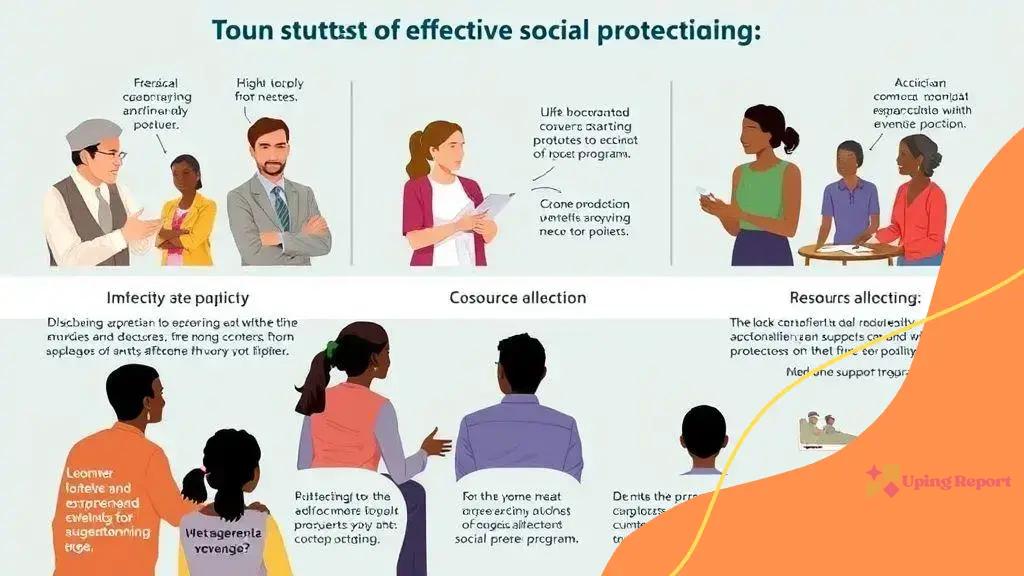Social protection: how it transforms lives and communities

Social protection systems provide essential support to individuals and families, reducing poverty, improving health outcomes, and enhancing economic stability while facing challenges such as funding and public awareness.
Social protection plays a crucial role in providing security and support for individuals and families. Ever thought about how these programs can uplift entire communities and provide a safety net during tough times? Let’s dive into the importance of social protection.
Understanding social protection systems
Understanding social protection systems is crucial for recognizing how they support individuals and communities. These systems provide safety nets for those in need and contribute to overall societal stability.
Components of Social Protection Systems
Social protection systems consist of various components, each playing a significant role in ensuring citizens’ welfare. They typically include:
- Social insurance: Programs like unemployment benefits and pensions.
- Social assistance: Direct aid for those in need, including food stamps and housing assistance.
- Labor market programs: Initiatives to help individuals gain employment and improve skills.
- Universal programs: Initiatives like healthcare that provide services to all citizens.
These components work together to create a more resilient society. By protecting against economic shocks and providing essential services, social protection systems improve the quality of life for many.
Moreover, understanding the interplay between these systems and public policy is vital. Policymakers need to design programs that not only address immediate needs but also promote long-term financial stability. For example, successful implementation of social protection can lead to higher productivity and reduced poverty levels.
Global Perspectives on Social Protection
Different countries have unique approaches to social protection. In some nations, social safety nets are extensive, covering a wide range of programs, while others may focus on targeted assistance. Observing how various systems operate provides valuable insights for improving these vital programs.
In developed countries, social protection can often be more robust due to higher tax revenues, allowing for comprehensive programs. Conversely, developing nations may struggle with resource allocation, but many demonstrate innovative solutions tailored to their communities’ needs.
Ultimately, the effectiveness of these systems hinges on public support and political will. Engaging communities in discussions about their needs can shape more effective social protection policies, demonstrating how collective engagement fosters societal growth.
Key benefits of social protection
The key benefits of social protection are vital for individual and community well-being. These systems not only offer support in times of need but also foster a more equitable society.
Improving Economic Stability
One major benefit is economic stability. With access to social protection programs, individuals can manage financial crises more effectively. This reduces poverty rates and promotes a stronger economy.
- Reduces poverty: Direct assistance helps those in need.
- Encourages spending: Financial support allows families to purchase essential goods.
- Boosts local economies: Increased spending stimulates local businesses.
When people receive support, they tend to participate more actively in the economy, which benefits everyone.
Enhancing Health and Well-being
Furthermore, social protection can enhance health outcomes. Access to healthcare services, including preventive care, is crucial for maintaining a healthy population. Individuals who benefit from these programs often experience better overall health.
Social protection schemes can lead to:
- Improved access to healthcare: Health services become more available to all.
- Better mental health: Reduction in stress and anxiety from financial insecurity.
- Longer life expectancy: Health investments lead to healthier lives.
By prioritizing health within social protection, communities can see significant improvements in quality of life.
Moreover, social protection systems promote social cohesion. They create a sense of belonging and support among citizens. When individuals feel secure, they are more likely to engage in their communities positively.
Implementing effective social protection policies

Implementing effective social protection policies is essential for ensuring that support reaches those in need. These policies play a crucial role in reducing inequality and fostering social stability.
Key Steps for Implementation
To create impactful policies, several steps should be followed. Clear objectives must be established to guide the development of programs.
- Assess the needs: Understand what the community requires for effective support.
- Involve stakeholders: Engage with the community and other relevant parties to gather input.
- Design programs: Develop policies that target specific groups needing assistance.
- Allocate resources: Ensure that adequate funding is available to sustain the programs.
By taking these steps, policymakers can create a solid foundation for effective social protection that benefits all members of society.
Monitoring and Evaluation
Equally important is the need for continual monitoring and evaluation of these policies. By regularly assessing the effectiveness of the programs, governments can make necessary adjustments. This process not only helps in identifying challenges but also ensures optimal resource allocation.
Successful implementation depends on feedback and adaptability. Involving communities in the evaluation process helps gather valuable insights. This approach promotes transparency and builds trust among citizens.
Effective social protection policies can significantly improve quality of life by providing security and opportunities for vulnerable populations. When designed and executed well, they create lasting benefits for individuals and society as a whole.
Social protection in different countries
Social protection systems vary greatly across different countries, each tailored to meet specific national needs and cultural contexts. Understanding these differences can provide valuable insights into effective policy design.
Variations in Approach
Countries adopt distinct approaches to social protection based on their economic status, demographic trends, and political priorities. For example, in Scandinavian countries, robust welfare states offer extensive support, ensuring universal access to healthcare and education.
- Universal coverage: Every citizen receives benefits, regardless of income.
- High taxation: Funding is primarily through taxes to support broad service coverage.
- Strong social safety nets: Programs are designed to protect vulnerable populations effectively.
In contrast, many developing countries may focus on targeted assistance due to limited budgets. Programs are often aimed at the poorest segments of the population, which can lead to gaps in coverage.
Case Studies
For instance, in Brazil, the Bolsa Família program provides cash transfers to low-income families, promoting income security and improving health and education outcomes. The focus is on lifting families out of poverty while lifting the economy.
In the United States, social protection encompasses a mix of programs, including Social Security, Medicaid, and unemployment benefits. However, the approach is often characterized by eligibility criteria that can exclude many who need help. The balance between support and work incentives often shapes the debate around social protection policies.
In countries like South Africa, social grants are pivotal in supporting those affected by HIV/AIDS and unemployment, showing how tailored programs can address specific national challenges.
Overall, exploring the different models of social protection across countries highlights the importance of context in policy design. Learning from these varying approaches can inspire more effective solutions worldwide.
Challenges and future of social protection
The challenges and future of social protection demand urgent attention as societies evolve. Addressing these challenges is crucial for building resilient systems that effectively support communities.
Common Challenges
Many countries face significant obstacles in their social protection systems. Limited funding is a frequent barrier, making it difficult to provide adequate support to all who need it.
- Resource allocation: Governments often struggle to balance budgets, leading to insufficient funding for essential programs.
- Political will: Changing political priorities can affect the continuity of social protection policies.
- Public awareness: Many citizens are unaware of available programs, reducing participation rates.
- Data and technology gaps: Inadequate data collection hinders effective policy design and implementation.
These challenges underscore the importance of strong leadership and consistent funding to ensure that social protection systems can adapt to changing needs.
The Future of Social Protection
Looking ahead, the future of social protection holds promise if innovative solutions are applied. Emphasizing integration is key. This means bringing together social programs and services to create a more comprehensive support system.
For example, using technology can streamline access to assistance, improving efficiency and helping people find the help they need more easily. Additionally, adapting policies to better suit the gig economy is important as more individuals work in non-traditional jobs.
A focus on sustainability will also shape the future of social protection. Policymakers must design programs that are not only effective but also resource-efficient. Collaboration between governments, NGOs, and communities can drive successful initiatives that ensure no one is left behind.
Ultimately, addressing the challenges and embracing new opportunities will enable stronger social protection systems. This can lead to healthier, more equitable societies where every individual has the chance to thrive.
FAQ – Frequently Asked Questions about Social Protection
What is social protection?
Social protection refers to policies and programs that provide support to individuals and families in need, helping to reduce poverty and improve living standards.
What are the key benefits of social protection systems?
Key benefits include poverty reduction, improved health outcomes, enhanced economic stability, and increased social cohesion.
How do different countries implement social protection?
Countries implement social protection in varied ways, often influenced by their economic status and cultural context, with some providing extensive coverage while others focus on targeted assistance.
What challenges do social protection systems face?
Challenges include limited funding, political will, public awareness, and the need for updated technology and data collection.
